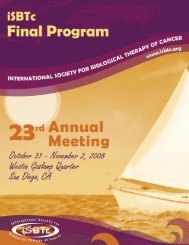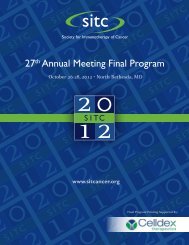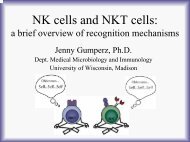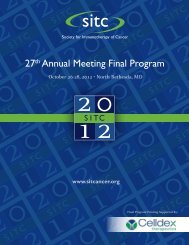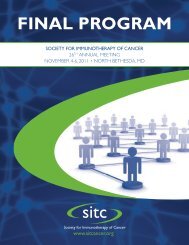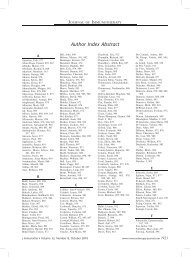Abstracts for the 25th Annual Scientific Meeting of the International ...
Abstracts for the 25th Annual Scientific Meeting of the International ...
Abstracts for the 25th Annual Scientific Meeting of the International ...
You also want an ePaper? Increase the reach of your titles
YUMPU automatically turns print PDFs into web optimized ePapers that Google loves.
J Immuno<strong>the</strong>r Volume 33, Number 8, October 2010<br />
<strong>Abstracts</strong><br />
response after completion <strong>of</strong> vaccine while <strong>the</strong> remaining two<br />
demonstrated stable disease. Among <strong>the</strong> <strong>for</strong>mer, one subject<br />
progressed through bev/cy, but had objective response to<br />
DCVax-L. Humoral responses were elicited in <strong>the</strong> 2 patients that<br />
experienced objective response, and an HLA-A0201-restricted,<br />
Her2-specific T cell response was documented following vaccination<br />
in one patient. The over all clinical benefit achieved in this<br />
study is 60% (2PR, 2SD and 2PD).<br />
Interpretation: Our results suggest <strong>the</strong> use <strong>of</strong> combinatorial cellular<br />
immuno<strong>the</strong>rapy comprising bev/cy with DC vaccination with<br />
whole tumor antigen <strong>for</strong> <strong>the</strong> treatment <strong>of</strong> patients with recurrent<br />
ovarian cancer was well tolerated and warrants fur<strong>the</strong>r investigation.<br />
Targeting Soluble Tumor Associated Antigens CEA and<br />
HER2 to Exosomes Enhances Antigen Specific Immune<br />
Reponses<br />
H.K. Lyerly*, Jean Bernard Le Pecqw, Zach Hartman*, Tim Clay*,<br />
Alain Delcayrew, Yanal Murad*. *Comprehensive Cancer Center,<br />
Duke University, Durham, NC; w Exo<strong>the</strong>ra, Menlo, CA.<br />
Patients with cancer may have detectable levels <strong>of</strong> tumor associated<br />
antigens (TAAs) in <strong>the</strong>ir circulation, but usually have minimal<br />
adaptive immune responses to those antigens. The immunogenicity<br />
<strong>of</strong> soluble protein differs from protein associated with membrane<br />
vesicles (exosomes), and this difference may explain <strong>the</strong> minimal<br />
immune response directed against circulating self or TAAs.<br />
Adaptive immunity to model TAAs has been enhanced in<br />
experimental animal models by directing antigen expression into<br />
exosomes. We sought to enhance <strong>the</strong> immunogenicity <strong>of</strong> common<br />
circulating TAAs by generating recombinant adenoviral vectors<br />
expressing <strong>the</strong> TAA coupled to <strong>the</strong> factor VIII-like C1C2 domain<br />
<strong>of</strong> milk fat globule epidermal growth factor-factor VIII (MFG-E8)/<br />
lactadherin which targets <strong>the</strong>m to exosomes. We created novel<br />
adenoviral vectors expressing one <strong>of</strong> two non-mutated TAAs,<br />
including two <strong>of</strong>ten found in <strong>the</strong> circulation <strong>of</strong> cancer patients,<br />
carcinoembyronic antigen (CEA), and <strong>the</strong> extracellular domain<br />
(ECD) <strong>of</strong> HER2. We compared <strong>the</strong>se novel vectors to vectors<br />
expressing <strong>the</strong> nondirected antigens in animal models to determine<br />
if exosomal targeting enhanced immunogenicity. We saw robust<br />
improvement in antigen specific immune responses to each <strong>of</strong> <strong>the</strong>se<br />
antigens and conclude that <strong>the</strong> mode <strong>of</strong> secretion can influence <strong>the</strong><br />
immunogenicity <strong>of</strong> TAAs expressed by viral vectors. This finding<br />
may explain <strong>the</strong>ir lack <strong>of</strong> immunogenicity <strong>of</strong> circulating TAAs, and<br />
may be used to enhance future antitumor vaccination protocols.<br />
Comparative Analysis <strong>of</strong> Cytotoxic T Lymphocyte Cell<br />
Response <strong>of</strong> Dendritic Cells Loaded with Hepatocellular<br />
Carcinoma -Derived RNA or Cell Lysate<br />
Ke Pan, Hui Wang, Jing-jing Zhao, Jian-chuan Xia. State Key<br />
Laboratory <strong>of</strong> Oncology in Sou<strong>the</strong>rn China, Sun Yat-sen University<br />
Cancer Center, Guangzhou, China.<br />
The choice <strong>of</strong> <strong>the</strong> tumor antigen preparation used <strong>for</strong> dendritic cells<br />
(DCs) loading is important <strong>for</strong> optimizing DC vaccines. In <strong>the</strong><br />
present study, we compared DCs pulsed with hepatocellular<br />
carcinoma (HCC) total RNA or cell lysates <strong>for</strong> <strong>the</strong>ir capacity to<br />
activate T cells. We showed here that HCC total RNA pulsed-DCs<br />
induced effector T lymphocyte responses which showed higher<br />
killing HCC cell lines ability, as well as higher frequency <strong>of</strong> IFN-g<br />
production <strong>of</strong> CD4+ and CD8+ T cells when compared with<br />
lysate pulsed-DCs. Both <strong>of</strong> RNA and lysate loading did not<br />
influence <strong>the</strong> changes <strong>of</strong> mature DC phenotype and <strong>the</strong> capacity <strong>of</strong><br />
inducing T cells proliferation. However, HCC lysate loading<br />
significantly inhibited <strong>the</strong> production <strong>of</strong> inflammatory cytokines<br />
IL-12p70, IFN-g and enhanced <strong>the</strong> secretion <strong>of</strong> anti-inflammatory<br />
cytokines IL-10 <strong>of</strong> mature DCs. Our results indicated that DCs<br />
loaded with HCC RNA are superior to that loaded with lysate in<br />
priming anti-HCC CTL response, suggesting that total RNA may<br />
be a better choice <strong>for</strong> DCs-based HCC immuno<strong>the</strong>rapy.<br />
A Peptide Derived from EBV-gH Glycoprotein That<br />
Reproduces Several Inhibitory Effects <strong>of</strong> EBV on Monocyte<br />
Derived Dendritic Cells<br />
Carlos A. Parra-Lo´pez*, Darnel A. Marchenaw, Mauricio<br />
Urquiza Martínezz, Johanna Melo Cárdenasz, Magnolia<br />
Vanegasz, Manuel E. Patarroyo Murilloz. *Microbiology and<br />
Immunology, Universidad Nacional de Colombia; w Immunology and<br />
Oncology Research Group, Fundacio´n Salud de los Andes; zVirology<br />
Group, Fundacio´n Instituto de Inmunologı´a de Colombia (FIDIC),<br />
Bogota´, Colombia.<br />
By interacting with B cells, epi<strong>the</strong>lial cells and monocytes, Epstein-<br />
Barr virus (EBV) has been implicated in developing several<br />
malignant tumors such as nasopharyngeal carcinoma, Burkitt’s<br />
lymphoma and <strong>the</strong> X-associated lymphoproliferative disease. EBV<br />
interact with monocyte-derived dendritic cells (MoDCs) mainly<br />
through EBV proteins gp350/220 and gp42/gH/gp25 (gp42/gH/gL)<br />
complex which binds to CD21 (CR2), MHC Class II and <strong>the</strong><br />
integrins avb6 and avb8. EBV produces in MoDCs different effects<br />
including inhibition <strong>of</strong> development, apoptosis and induction <strong>of</strong><br />
cytokines that both stimulate and inhibit activation <strong>of</strong> Th1 CD4+<br />
T cells (IL-12 and IL-10/IL-6). The glycoprotein gp85 also named<br />
EBV-gH protein has a role in <strong>the</strong> binding <strong>of</strong> EBV to MoDCs<br />
through peptides 11435 (181TYKRVTEKGDEHVLSLVFGK200)<br />
and 11438 (241YFVPNLKDMFSRAVTMTAAS260). Here we<br />
describe that an analogue peptide from 11438 with a stable alphahelix<br />
(herein named P33210) has similar effects on MoDCs as EBV<br />
does. Cells cultured with this peptide remarkably displayed a delay<br />
in <strong>the</strong> MoDCs development evidenced by induction <strong>of</strong> apoptosis,<br />
sustained CD14 expression and impaired expression <strong>of</strong> DC-SIGN,<br />
CD83 and HLA-DR. Interestingly, in MoDCs from several normal<br />
donors, P33210 induced high levels <strong>of</strong> IL-12p70 syn<strong>the</strong>sis in<br />
complete absence <strong>of</strong> IL-10 that persisted longer than that elicited<br />
by EBV. Altoge<strong>the</strong>r, <strong>the</strong>se results suggest that peptide P33210<br />
may be a tool to dissect activation pathways leading to apoptosis/<br />
IL-12 production and/or inhibition <strong>of</strong> MoDCs maturation induced<br />
by EBV.<br />
Induction <strong>of</strong> Systemic and Therapeutic Antitumor Immunity<br />
Using Intratumoral Injection <strong>of</strong> Bone-Marrow Derived<br />
Dendritic Cells Genetically Modified to Express IL-23<br />
Marimo Sato-Matsushita*, Kimiyasu Yoneyama*w, Takafumi<br />
Nakamura*, Yuko Kitagawaw, Hideaki Tahara*. *Institute <strong>of</strong><br />
Medical Science, The University <strong>of</strong> Tokyo; w Department <strong>of</strong> Surgery,<br />
Keio University School <strong>of</strong> Medicine, Tokyo, Japan.<br />
Purpose: We have reported that <strong>the</strong> systemic administration <strong>of</strong><br />
IL-23 induces potent antitumor immunity primarily mediated<br />
when <strong>the</strong> Th1-type response is fully promoted in <strong>the</strong> presence <strong>of</strong><br />
endogenously expressed IL-12. In this study, we investigated<br />
whe<strong>the</strong>r bone marrow- derived dendritic cells (BM-DCs) adenovirally<br />
transduced with genes encoding murine IL-23 have <strong>the</strong>rapeutic<br />
benefits <strong>for</strong> antitumor immuno<strong>the</strong>rapy.<br />
Experiment Design and Results: We made RDG fiber-mutant<br />
adenovirus (Ad) vectors encoding IL-23 or EGFP. The MCA205<br />
fibrosarcoma was intradermally inoculated to C57BL/6, and <strong>the</strong><br />
mice were intratumorally injected with BM-DCs transduced with<br />
Ax3CAmIL23/RGD (Ad-IL-23-DCs) on day 8. The tumors <strong>of</strong><br />
mice treated with AD-IL-23-DCs resulted in significant growth<br />
suppression when compared to that with BM-DCs transduced Ad-<br />
EGFP-F/RGD (Ad-EGFP-DCs). Ad-IL-23-DCs treatment induced<br />
MCA-205-specific and potent CTL responses in draining<br />
lymph node. Fur<strong>the</strong>rmore, The NK activity also increased in<br />
splenocytes at levels greater than those <strong>of</strong> Ad-EGFP-DCs. In<br />
addition, The significant induction <strong>of</strong> IFN-g and IL-17 and<br />
decrease <strong>of</strong> Foxp3+CD4+Tregs in TIL were strongly suggested<br />
in <strong>the</strong> mice injected with Ad-IL-23-DCs when compared with those<br />
<strong>of</strong> Ad-EGFP-DCs.<br />
Conclusion: This strategy designed to deliver genetically modified<br />
DCs to tumor sites is associated with systemic and <strong>the</strong>rapeutic<br />
antitumor immunity and could be an alternative approach to those<br />
r 2010 Lippincott Williams & Wilkins www.immuno<strong>the</strong>rapy-journal.com | 879



